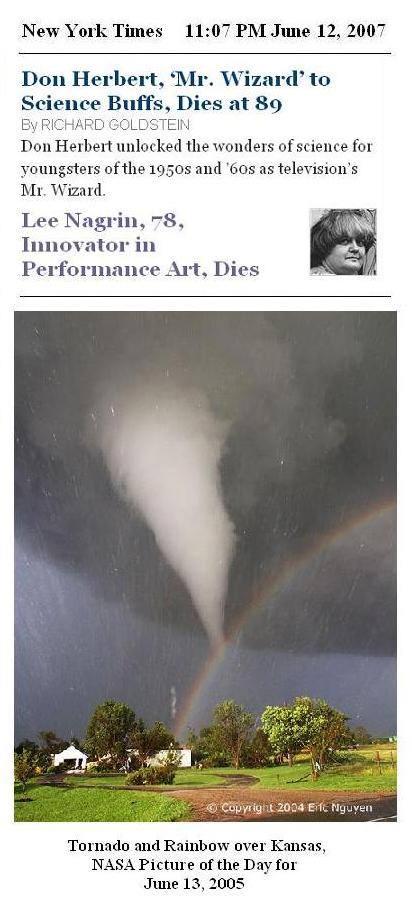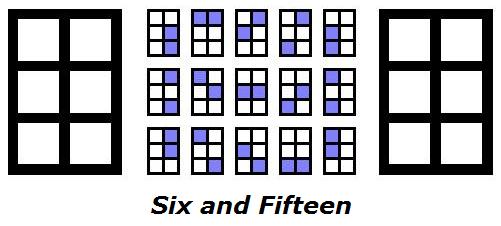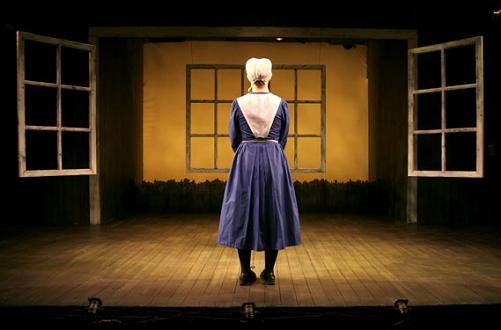From the journal of Steven H. Cullinane...
2009 June 01-15
Sunday, June 14, 2009 11:00 AM
Today's Sermon:
Saturday, June 13, 2009 2:09 PM
ART WARS continued:
Friday, June 12, 2009 11:07 PM
The Two-Cultures War continues...
New York Times
Friday, June 12, 2009, 4:14 PM
By John Tierney
At the World Science Festival Thursday night [June 11,
2009], four physicists offered an answer to the question that has
plagued philosophers and scientists: Why is there something rather than
nothing at all?
|
Sure they did.
Two
years ago:

"A strange thing
then happened."
-- L.
Frank Baum
Related material:
Introduction
to
Abstract
Classicism
Thursday, June 11, 2009 7:11 PM
Art and Man at Yale:
Geometry for Jews
(continued from
Michelangelo's birthday, 2003)

"Discuss the geometry
underlying the above picture."
-- Log24,
March 6, 2003
Abstraction
and the Holocaust (Mark Godfrey, Yale University Press, 2007)
describes one approach to such a discussion:
Bochner
"took a photograph of a new arrangement of blocks, cut it up, reprinted
it as a negative, and arranged the four corners in every possible
configuration using the serial principles of rotation and reversal to
make Sixteen Isomorphs (Negative) of 1967, which he later
illustrated alongside works by Donald Judd, Sol LeWitt and Eva Hesse in
his Artforum article 'The Serial Attitude.' [December 1967, pp.
28-33]"
Bochner's picture of "every possible configuration"--
Compare with the 24 figures in Frame
Tales (Log24, Nov. 10, 2008) and in Theme and
Variations.
Thursday, June 11, 2009 2:28 AM
Design Theory, continued:
Wednesday, June 10, 2009 6:29 PM
Annals of Literature:
Hello, Columbus
continued from
the two entries of
October
12, 2003:
Part I --
October 12, 2003 --

Above, an image from
Spinnin' Wheel,
Spinnin' True
Part II --
October 12, 2003 --

Above, an image from
Hello, Columbus
Part III --
June 10, 2009 --
Below, images from
a website:

"They all laughed at
Christopher Columbus..."
-- Ira Gershwin
Wednesday, June 10, 2009 2:02 AM
For the Talented:
Death of an
Abstract Classicist
"It's going to be accomplished
in steps, this establishment of
the
Talented in the
scheme of things."
-- Anne McCaffrey, Radcliffe '47


Click on images to enlarge.
Related material:
Naturalized
Epistemology
and
Zero
Factorial.
Tuesday, June 9, 2009 2:56 PM
A Sermon About Nothing:
Recessional
"I know what
nothing means."
-- Joan Didion,
Play It As It Lays
 Faust
Faust
President Faust of Harvard on
Joan Didion:
"She was referring to life as a kind of improvisation: that magical
crossroads of rigor and ease, structure and freedom, reason and
intuition. What she calls being prepared to 'go with the change.'"
Didion's own words:
"I think about swimming with him into the cave at Portuguese Bend,
about the swell of clear water, the way it changed, the swiftness and
power it gained as it narrowed through the rocks at the base of the
point. The tide had to be just right. We had to be in the water at the
very moment the tide was right. We could only have done this a half
dozen times at most during the two years we lived there but it is what
I remember. Each time we did it I was afraid of missing the swell,
hanging back, timing it wrong. John never was. You had to feel the
swell change. You had to go with the change. He told me that. No eye is
on the sparrow but he did tell me that."
From the same book:
"The craziness is receding but no clarity is taking its place."
-- Joan Didion, The
Year of Magical Thinking
For a magical crossroads at another university, see the five
Log24 entries ending on November 25, 2005:
Saturday, June 6, 2009 2:02 PM
ART WARS continued:
 Excerpts from Log24,
Excerpts from Log24,
with commentary by
Wilhelm and Mather
Thursday, June 4, 2009 1:24 PM
Honorary Degree:
The Grasshopper
Lies Heavy

"'Oracle, why did you write
The Grasshopper Lies Heavy?
What are we supposed to learn?'"
-- Philip K. Dick
"
She
began throwing the coins."

Click on image
for further details.
Thursday, June 4, 2009 10:30 AM
First-Draft Theater continues...
A Passage to Egypt
Thursday, June 4, 2009 12:00 AM
ART WARS continued:
New collection release:
Pattern in Islamic Art
from David Wade
David Wade has partnered with ARTstor to distribute
approximately 1,500 images of Islamic art, now available in the Digital
Library. These images illustrate patterns and designs found throughout
the Islamic world, from the Middle East and Europe to Central and South
Asia. They depict works Wade photographed during his travels, as well
as drawings and diagrams produced for publication. Reflective of Wade's
particular interest in symmetry and geometry, these images analyze and
break down common patterns into their basic elements, thereby revealing
the underlying principles of order and balance in Islamic art.
Islamic artists and craftsmen employed these intricate patterns to
adorn all types of surfaces, such as stone, brick, plaster, ceramic,
glass, metal, wood, and textiles. The collection contains examples of
ornamentation from monumental architecture to the decorative arts.
To view the David Wade: Pattern in Islamic Art collection: go to the
ARTstor Digital Library, browse by collection, and click "David
Wade: Pattern in Islamic Art;" or enter the Keyword Search:
patterninislamicart.
For more detailed information about this collection, visit the
David Wade: Pattern in
Islamic Art collection page.
|
The above prose illustrates
the institutional mind at work.
Those who actually try to view
the Wade collection will
encounter the following warning:
| To access the images in the ARTstor Digital
Library you need to be affiliated with a participating institution
(university, college, museum, public library or K-12 school). |
Wednesday, June 3, 2009 4:00 AM
Maximus and the Star--
Epigraphs
to Four Quartets:

The Dissertations of Maximus Tyrius, translated from the Greek by
Thomas Taylor, printed by C. Whittingham, London, for the translator,
1804, Vol. II, p. 55:
"You see the mutation of bodies, and the transition of generation, a
path upwards and downwards according to Heraclitus; and again, as he
says, one thing living the death, but dying the life of another. Thus
fire lives the death of earth, and air lives the death of fire; water
lives the death of air, and earth lives the death of water. You see a
succession of life, and a mutation of bodies, both of which are the
renovation of the whole."

For an interpretation
of the above figure
in terms of the classical
four elements discussed
in
Four Quartets,
in
Dissertations, and
in
Angels & Demons,
see
Notes
on Mathematics
and
Narrative.
For a more entertaining
interpretation, see Fritz Leiber's
classic story "
Damnation
Morning."
Tuesday, June 2, 2009 11:30 AM
Science, Faith, & Bad Movies continued:
Get Quotes
Monday, June 1, 2009 10:31 AM
Mathematics and Narrative, continued:
"The action is in the plot,
inaccessible to introspection, and only the
characters know what's going on."
-- James
Hillman, quoted at David
Lavery's weblog.
See also
 Click on image
Click on image
for further details.


















